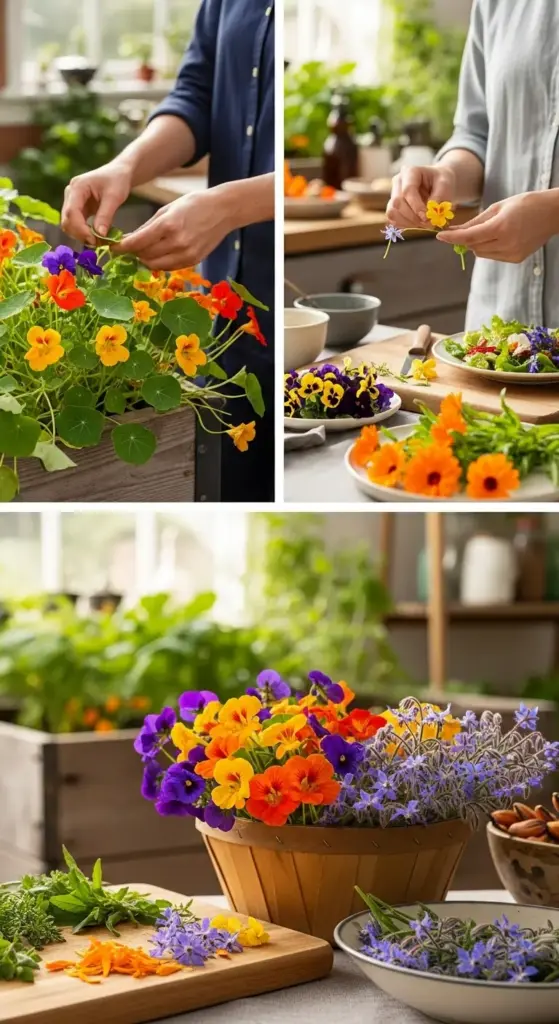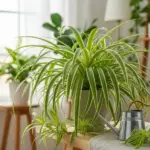7. Edible Flower Garden: Beauty You Can Taste

The first time I bit into a nasturtium flower, my mind was completely blown. It tasted like peppery sunshine with a hint of watercress – who knew flowers could be this delicious?
My edible flower garden started as a curiosity and became an obsession. Now I can’t imagine cooking without these gorgeous, flavorful blooms.
Safe Flowers That Won’t Kill You
Safe edible flowers was my biggest concern when I started – and rightfully so! Not all pretty flowers are dinner-friendly.
Nasturtiums are the perfect beginner edible bloom. Every part is edible, they’re impossible to confuse with anything toxic, and they taste amazing in salads.
Violas and pansies have a mild, slightly sweet flavor that’s perfect for cocktail garnishes. I grow them specifically for food photography – they’re like edible confetti!
Calendula petals taste slightly peppery and add gorgeous orange color to soups and rice dishes. These culinary flowers are basically nature’s saffron substitute.
Borage flowers taste like cucumber and look like tiny blue stars. They’re incredible frozen in ice cubes for summer cocktails.
Rose petals from fragrant varieties make beautiful edible garnishes. Just make sure they’re pesticide-free and actually smell good – scentless roses taste like nothing.
Never eat flowers from florists, roadsides, or unknown sources. When in doubt, don’t risk it.
Kitchen Garden Integration
Herb garden integration makes perfect sense once you realize many herbs have edible flowers too.
Basil flowers are actually more intensely flavored than the leaves. I let some plants bolt specifically for these culinary blooms.
Chive blossoms break apart into individual purple florets that taste like mild onions. They’re gorgeous scattered over cream soups or potato salad.
Lavender flowers require careful variety selection – English lavender tastes floral and sweet, while other types can be soapy or bitter.
My kitchen landscaping puts edible flowers within easy reach of the back door. Window box herbs with blooming tops provide instant cooking garnishes.
Companion planting works beautifully – nasturtiums climbing through tomato cages provide pest control and salad ingredients simultaneously.
Food Photography Magic
Edible flowers transformed my food photography from amateur snapshots to magazine-worthy images.
Viola faces make every dish look professionally styled. These tiny edible blooms photograph beautifully and add instant elegance.
Nasturtium leaves and flowers create gorgeous color contrast against green salads. The round leaves provide perfect backdrop for other ingredients.
Borage flowers frozen in ice cubes create stunning cocktail photography. The blue flowers look like tiny jewels suspended in crystal.
Rose petal confetti scattered around dessert plates adds romantic elegance to food styling. I use different colored roses for seasonal themes.
Micro greens with their tiny flowers add texture and height to food photography compositions. Radish and arugula flowers are particularly photogenic.
Natural lighting shows edible flower colors most accurately. I photograph my flower-garnished dishes near windows for best results.
Nutritional Powerhouses
Health benefits of edible flowers surprised me – they’re not just pretty garnishes!
Nasturtium flowers are packed with vitamin C and natural antibiotics. These nutritious blooms were traditionally used to prevent scurvy.
Calendula petals contain anti-inflammatory compounds and have been used medicinally for centuries. They’re gentle enough for sensitive skin and stomachs.
Rose hips from spent rose flowers are incredibly high in vitamin C. I let some roses go to seed specifically for these nutritional treasures.
Violet flowers contain mucilage that soothes sore throats. Traditional herbalists used them in healing teas and syrups.
Dandelion flowers are liver detoxifiers and surprisingly tasty when young. Just make sure they’re from pesticide-free areas.
Hibiscus flowers make tart, vitamin C-rich teas that taste like cranberries. These edible blooms are popular in health-conscious cooking.
Preservation Techniques
Extending the harvest season requires creative flower preservation methods.
Freezing edible flowers in ice cube trays preserves both beauty and flavor. I make floral ice cubes for summer entertaining all season long.
Drying nasturtium seeds creates homemade capers with incredible peppery flavor. These preserved flower buds last months in vinegar.
Rose petal sugar captures summer fragrance for winter baking. Layer fresh rose petals with sugar and let time work its magic.
Flower vinegars preserve both flavor and color beautifully. Chive blossom vinegar turns gorgeous purple and tastes amazing on salads.
Candied flowers using egg whites and superfine sugar create elegant dessert decorations that last weeks.
Flower salts made with dried lavender or rose petals add gourmet touches to home cooking year-round.
Culinary Adventures
Recipe ideas using edible flowers range from simple to spectacular.
Nasturtium pesto substitutes flowers and leaves for traditional basil. The peppery flavor is incredible with pasta or grilled vegetables.
Violet syrup made from fresh violet flowers creates gorgeous purple cocktail ingredients and pancake toppings.
Rose petal jam tastes like summer in a jar. I make small batches using fragrant garden roses and minimal sugar.
Flower butter combines softened butter with minced chive blossoms or calendula petals. These flavored butters elevate simple bread into gourmet treats.
Hibiscus agua fresca uses dried hibiscus flowers for refreshing summer beverages with gorgeous ruby color.
Edible flower salads showcase multiple blooms together – nasturtiums, violas, and calendula create rainbow-colored gourmet salads.
Flower ice cream infused with rose petals or lavender makes elegant dinner party desserts.
Start simple with nasturtiums in green salads, then experiment with more adventurous culinary flower combinations. The key is tasting as you go and having fun with these edible garden treasures!
Conclusion
These seven backyard flower garden ideas prove that it’s never too late in the season to create something beautiful! Whether you’re drawn to the romantic charm of a cottage garden or the sleek sophistication of modern minimalist beds, there’s a perfect style waiting to transform your outdoor space.
Remember, the best garden is one that fits your lifestyle and brings you joy. Start with one idea that speaks to you, gather your supplies, and begin creating your personal outdoor sanctuary. Your future self will thank you next spring when your garden bursts into glorious bloom!
Ready to get started? Choose your favorite idea from our list and begin planning your late-summer garden transformation today. Don’t forget to share your progress on social media – we’d love to see your beautiful creations come to life!









GIPHY App Key not set. Please check settings